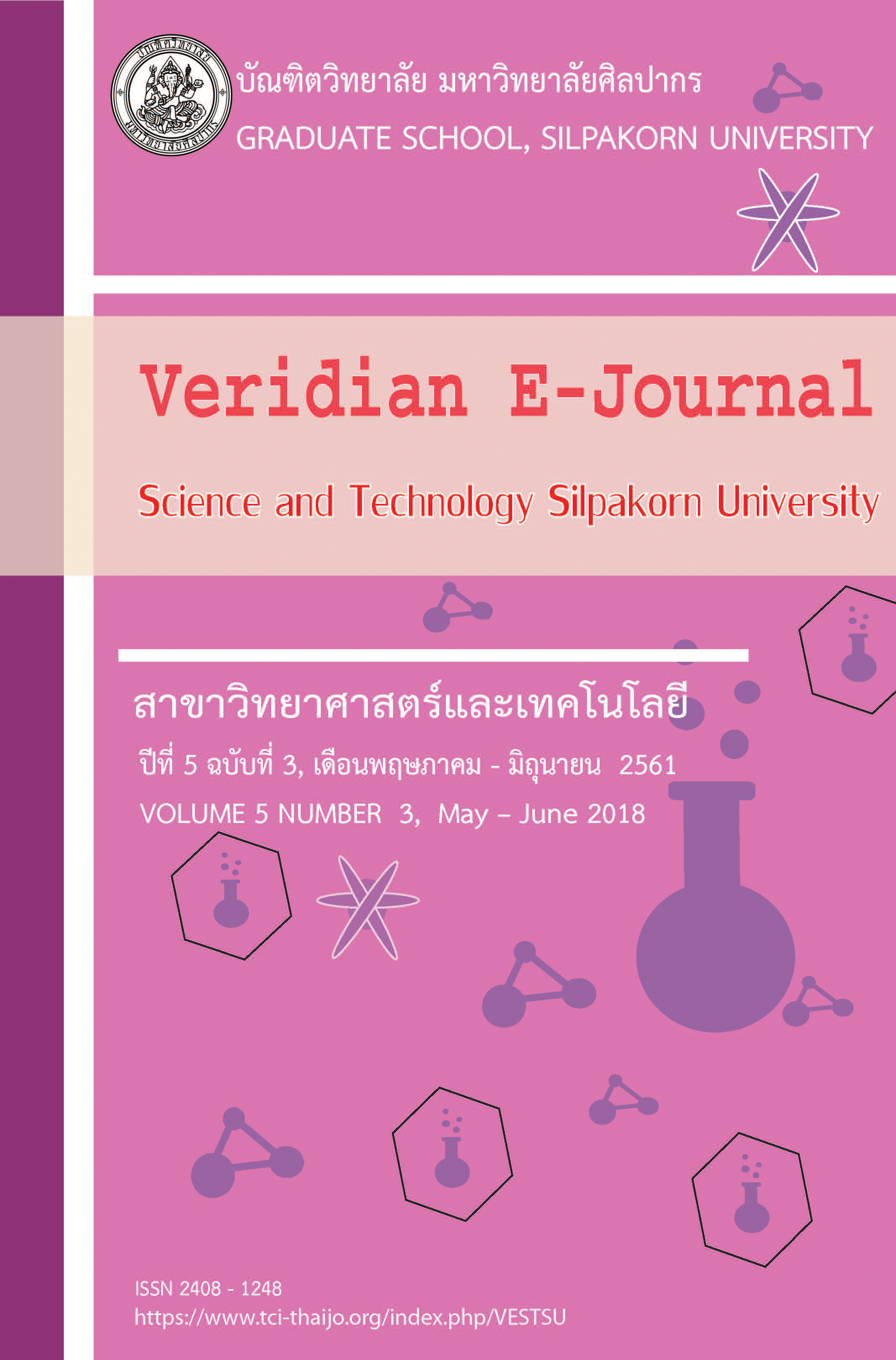การประมาณขนาดประชากรและสร้างตัวแบบทำนายเพศนกประจำถิ่น ในเขตห้ามล่าสัตว์ป่าบึงบอระเพ็ด จังหวัดนครสวรรค์ (Population Size Estimation and Sexual Predictive Model Construction of the Resident Birds in Bueng Boraphet Non-Hunting Area, Nakhon Sawan Province)
Main Article Content
Abstract
งานวิจัยครั้งนี้มีวัตถุประสงค์เพื่อประมาณค่าแบบช่วงของขนาดประชากรนกประจำถิ่นในเขตห้ามล่าสัตว์ป่าบึงบอระเพ็ด จังหวัดนครสวรรค์ ที่ระดับความเชื่อมั่น 95% ด้วยวิธีจับซ้ำโดยใช้ตัวประมาณ 3 ตัว คือ ตัวประมาณของ Zelterman, ตัวประมาณของ Chao และตัวประมาณแบบถ่วงน้ำหนัก นอกจากนี้ในงานวิจัยยังมีการสร้างตัวแบบการทำนายเพศนกกระติ๊ดแดง ซึ่งเป็นนกประจำถิ่นชนิดหนึ่ง ผลการศึกษาพบว่า การประมาณขนาดประชากรนกประจำถิ่นแบบจุดโดยใช้ตัวประมาณของ Chao ให้ค่าประมาณความคลาดเคลื่อนมาตรฐานต่ำที่สุด และมีช่วงความเชื่อมั่น 95% ของขนาดประชากรนกประจำถิ่นอยู่ระหว่าง 2,234.005 ถึง 6,575.783 ส่วนตัวประมาณของ Zelterman และตัวประมาณแบบถ่วงน้ำหนักให้ค่าประมาณแบบจุดที่ใกล้เคียงกัน และให้ค่าประมาณความคลาดเคลื่อนมาตรฐานสูงกว่าตัวประมาณของ Chao แต่ตัวประมาณของ Chao มีความกว้างของช่วงความเชื่อมั่น 95% ของขนาดประชากรนกประจำถิ่นแคบกว่าตัวประมาณของ Zelterman และตัวประมาณแบบถ่วงน้ำหนัก สำหรับการสร้างตัวแบบทำนายเพศนกกระติ๊ดแดง พิจารณาจากตัวแปรอิสระ 6 ตัว ได้แก่ ความยาวปีก (x1), ความยาวท้ายทอยถึงปลายปาก (x2), ความยาวปาก (x3), ความยาวแข้ง (x4), ความยาวหาง (x5) และน้ำหนัก (x6) ซึ่งใช้เทคนิคการวิเคราะห์การถดถอยโลจิสติคและการวิเคราะห์จำแนกกลุ่ม สรุปได้ว่า การวิเคราะห์การถดถอยโลจิสติคมีอำนาจจำแนกได้ถูกต้องร้อยละ 91.30 สูงกว่าการวิเคราะห์จำแนกกลุ่มที่มีอำนาจจำแนกได้ถูกต้องร้อยละ 86.96 และตัวแปรอิสระที่ถูกคัดเลือกเข้าสมการถดถอยโลจิสติคโดยวิธี Forward Stepwise มี 5 ตัว ได้แก่ ความยาวปีก (x1), ความยาวท้ายทอยถึงปลายปาก (x2), ความยาวแข้ง (x4), ความยาวหาง (x5) และน้ำหนัก (x6) สำหรับการวิเคราะห์จำแนกกลุ่ม ตัวแปรอิสระที่ถูกคัดเลือกเข้าสมการจำแนกกลุ่มโดยวิธี Stepwise มี 4 ตัว ได้แก่ ความยาวปีก (x1), ความยาวแข้ง (x4), ความยาวหาง (x5) และน้ำหนัก (x6)
The purposes of this research were to estimate the population size of resident birds in Bueng boraphet non-hunting area, Nakhon Sawan province by using the 95% confidence interval of three estimators—Zelterman’s estimator, Chao’s estimator and Weighted estimator—for capture-recapture method. In addition, the sexual predictive models of red avadavat, one species of resident birds, were constructed. The results showed that the population size estimation of the resident birds by using Chao's estimator has the smallest estimated standard error for point estimation, and the 95% confidence interval of this is between 2,234.005 to 6,575.783. The point estimates of Zelterman's and Weighted estimators are close together and their estimated standard errors are higher than that of Chao’s estimator. However, the width of the 95% confidence interval of Chao's estimator for population size of the resident birds is narrower than those of Zelterman's and Weighted estimators. For the sexual predictive model construction of the red avadavat, six independent variables—wing length (x1), occipital to beak length (x2), beak length (x3), shin length (x4), tail length (x5), weight (x6)—are considered by using logistic regression and discriminant analysis. It is found that the percentage of correct prediction of logistic regression analysis is 91.30 that is higher than that of discriminant analysis which is equals 86.96. Further, the independent variables selection for fitting logistic regression model by forward stepwise method consists of five independent variables include, wing length (x1), occipital to beak length (x2), shin length (x4), tail length (x5) and weight (x6). For discriminant analysis, the independent variables selection for fitting discriminant function by stepwise method consists of four independent variables including, wing length (x1), shin length (x4), tail length (x5) and weight (x6).
